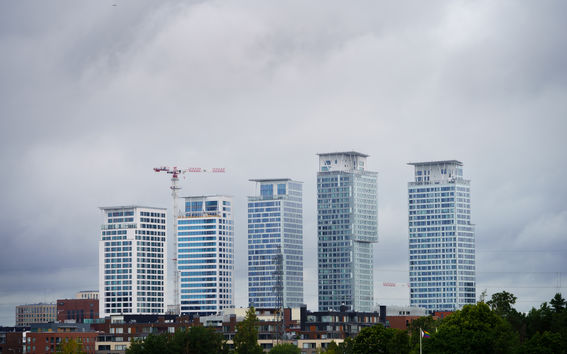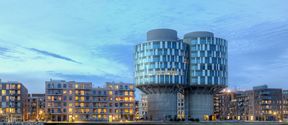ConWa: Contested Waterfront Transformation
This project investigates the outcomes of prevailing policy ideals of social inclusion in spatial development as they face variations of increasingly financialized urban growth machines.

The aims and goals for redeveloping land are tied to moral values. What is considered important, and what not? It can even be argued that the phenomenon of redevelopment itself is tied to a value system, or belief system, of constant growth. This constant growth is, of course, connected to the theory of the urban growth machine, as well as the financialization of land. Regardless, an often-overlooked consequence of development is the reshaping, or in some extreme cases even elimination, of the existing culture of the area in question. In that sense, the rebranding and redevelopment of land becomes a matter of heritage management.
As the objectives of economic growth remain at the heart of urban planning processes, it becomes relevant to examine the way in which existing built fabric is evaluated and handled. What types of buildings or infrastructures are considered preservable? The most typical categorization of built heritage is to view a certain building or a certain area as a “representation of national heritage”. That, then, begs the question of whose narrative the idea of “national heritage” represents. How much of this argument is based in the one-dimensional value system of land capitalization, and how much reflects heritage that the local communities relate to?
The problem that built heritage faces today is being caught in the in-between of rapid growth and stagnant conservation. It seems that a building either faces demolition and brand-new development, or static preservation that makes it unable to change or transform. In other words, the focus either lays on what an area could become, or what an area once has been, but not on what it currently is.
Areas need to grow and change as humanity keeps growing and changing. However, a top-down approach might lead to the segregation or elimination of existing cultures or sub-cultures. A grassroot approach to redeveloping an area might be the gateway to not only identify overlooked heritage, but also create a more flexible and natural transition as the area grows. Social and political participation throughout planning processes could make it possible for local communities to do value identification in their own areas. Furthermore, ensuring proper access to services, housing, and public spaces plants a seed for any contemporary culture to flourish. Rather than removing certain cultures, urban planning processes should be sensitive and self-aware when approaching an area with the purpose of land redevelopment in mind.
28.10.2024
Viola Schulman
Project Employee
Samalla kun märkä lumi tippui taivaalta, joukko tutkijoita ja opiskelijoita kokoontui Aalto-yliopiston kampukselle kuuntelemaan Veronica Conten vierasluentoa kaupunkipolitiikasta. Luento jakautui kahteen osaan. Ensimmäinen osa oli teoreettinen, keskittyen kaupunkiregimiteoriaan sekä korostaen vallan eri ulottuvuuksia kaupunkipolitiikassa. Toinen osa puolestaan syventyi Veronican tapaustutkimusten havaintoihin Brysselistä ja Milanosta.
Veronica kertoi, kuinka kaupunkiregimiteoria toimi hänen tutkimuksensa analyyttisena viitekehyksenä Milanossa ja Brysselissä. Kaupunkiregimiteoria ja kasvukoneteoria eroavat painotuksiltaan: kasvukoneteoria keskittyy talouskasvuun ja maankäytön kehittämiseen, kun taas kaupunkiregimiteoria painottaa hallintoa ja koalitioiden muodostamista. Koska Veronica tarkasteli tutkimuksessaan vallan dynamiikkaa kaavoitusprosessin aikana, kaupunkiregimiteoria osoittautui hänen työlleen erityisen osuvaksi.
Veronica toi myös esille, miten erilaiset kaupunkiaktiivit voivat haalia valtaa eri tavoin. Toimija voi esimerkiksi saavuttaa valta-aseman kiinteistö- ja maanomistuksella tai hyödyntämällä verkostojaan ja asiantuntemustaan maankäytön kehittämisessä. Käytännössä tämä voi tarkoittaa, että kansainvälisen sijoittajan on etsittävä paikallinen välittäjä. Välihenkilö osaa hoitaa tarvittavat paperityöt vieraassa kaupungissa, usein jopa kielellä, joita sijoittaja ei itse hallitse. Näin valtaa voidaan saavuttaa myös aineettomilla keinoilla.
Brysselin ja Milanon kaupunkihankkeet nojasivat joustavaan ja neuvottelevaan kaupunkisuunnittelumuotoon, jossa julkinen sektori pyrki löytämään yhteisen sävelen yksityisten omistajien ja sijoittajien kanssa. Molemmissa tapauksissa suunnittelu päätyi kuitenkin vahvasti yksityisen sektorin hallitsemaksi. Milanossa tilanne oli erityisen korostunut: sekä maa että kiinteistöt ovat täysin yksityisessä omistuksessa. Tämä tuo selkeästi esiin Helsingin erilaisuuden, sillä suuri osa kaupungin maasta on julkisessa omistuksessa. Veronica Conten havainnot Brysselin ja Milanon kaupunkipolitiikasta tarjosivat arvokasta kontekstia myös pohjoismaisen mallin tarkastelulle.
In the second week of May the ConWa team visited Turin and Milan to explore interesting local urban developments from the project’s perspective. Our colleagues at the University of Turin introduced us to the significant shift that has occurred in the city’s relationship to its many rivers: whereas before the rivers were taken for granted as resources for industry and sewers of the city, today they are being rediscovered as invaluable assets for the service economy, leisure and wellbeing. Some industrial areas have already been transformed into public space, such as the Parco Dora, but the local researchers stressed that many areas are still in need of transformation.
But the transformations of the riverfronts aren’t without contestations. We toured the Parco del Meisino, a nature hotspot at the junction of three important rivers flowing through Turin, the Po, Stura and Dora Rivers. Here, different ideas of nature in the city clash. A coalition of the city administration with business interests is looking to develop less flood prone areas of the park with more built infrastructure, such as for sports, but citizens are visibly protesting this because they want the park preserved as uncontaminated nature.
Turin’s rediscovery of its waterfronts due to deindustrialisation reflects global trends, and this is exactly what the ConWa project is interested to research in our case cities. Key questions in the contestations are who are the actors taking part? Who is the target audience of development? And, what social inclusion aims are taken into account and how?
In Milan, we had the pleasure of discussing these key questions of ConWa with colleagues at the Politecnico Department of Architecture and Urban Studies. Public land ownership in Nordic cities and private land ownership in Milan arose as a key difference in enabling social inclusion aims in policy and the power of the local growth machine in steering development. With the majority of the land in Milan privately owned, it has led to a situation where development of public spaces favour the interests of private developers and public dissatisfactions are curbed with the rhetoric that private developments are not a public question. Therefore much conflict is silenced. Additionally, the fact remains that current homeowners also gain from pro-growth coalitions’ aims of developing Milan into a city of finance and business, since housing prices are rising. But those who do not gain are pushed out.
Districts such as Porta Nuova and CityLife, which we toured, are materializations of the financialized growth machines at work in Milan. These high rise areas, sugar coated with names of star architects, public parks, and rhetoric of “smart” and “green”, stand out from the rest of the city. The ConWa group, together with colleagues from Politecnico, pondered on questions such as to what extent does working on public space contribute to equality and public good? And whom are the star architects supposed to legitimize these developments to? Some real concerns related to housing affordability and segregation also arose, related to both existing areas and new developments happening on old rail yards.
The group also enjoyed the more Italian parts of the city, experiencing the greatness of Italian food culture and admiring the works of local artisans of the fashion industry. On the ground floor leather workshop, new and old meet also through people. A financial lawyer walks in and familiarly greets the gentleman behind his sewing machine with a handshake that almost turns into a hug. The well dressed lawyer tells one of the group members how he cherishes the traditional work and the relaxed moments he has within the shop, in between his work in both Milan and London. Perhaps the 48 year old shop, in an even older building, feels more comfortable than the new high rise offices in which many people nowadays work.
20.5.2025
Aurora Luukkanen & Konsta Anastasiou
ConWa Research Assistants
Vierailimme Kööpenhaminassa elokuussa 2025. Matkan tarkoitus oli tutustua Nordhavnin kaupunginosaan, joka on yksi ConWan tutkimuskohteista. Nordhavnin rakennustyöt alkoivat 15 vuotta sitten, mutta suurin osa alueesta on yhä teollisuuskäytössä. Tämä kuvastaa alueen häkellyttävää laajuutta: kehitettävää maata on 200 hehtaaria, kun esimerkiksi Helsingin Kalasatamassa vastaavan hankkeen pinta-ala on 70 hehtaaria ja Tampereen Ranta-Tampellasssa noin 17 hehtaaria.
Suunnittelu Nordhavnin mittakaavassa on ollut haaste Kööpenhaminan kaupungille. Vieraillessamme Roskilden yliopistossa keskustelimme tanskalaisten kollegojemme kanssa siitä, kuinka Tanskassa oli vuosituhannen vaihtuessa pula tämän mittakaavan kaupunkisuunnittelun osaamisesta, koska sitä ei ollut tehty noin kolmeenkymmeneen vuoteen. Kaupunki on organisoinut laaja-alaisen maankäytön kehityksen kaupungin ja valtion omistamien kaupunkikehitysyhtiöiden kautta. Kehitysyhtiöillä aloitettiin ensin pienempien teollisuusalueiden – Sydhavnin rannan ja Ørestadin – kehittäminen 2000-luvun alussa. Vuonna 2007 perustettu By & Havn (Kaupunki ja Satama) -yhtiö on pääroolissa Nordhavnin kehityksessä. Nordhavnin ensimmäisen naapuruston, Århusgadekvarterin, rakentaminen alkoi 2014, ja nykyään siellä asuu noin 6 000 asukasta.
Keskustellessamme Nordhavnista paikalliset tutkijat korostivat sitä, kuinka tärkeää on ottaa huomioon luonto alueen suunnittelussa. Vaikka koko alue on vanhaa teollisuusaluetta, sinne on levittäytynyt paljon villiä luontoa ja jopa uhanalaisia lajeja, kuten kuningaskalastaja ja viherkonna, joka on eurooppalainen sammakkolaji. Luonnon monimuotoisuus on tiheimmillään Nordhavnstippenissä. Tätä monimuotoisuutta aiotaan suojella, ja Nordhavniin on suunnitteilla puisto suojelun saavuttamiseksi.
Koska puiston suunnittelukilpailu on parasta aikaa käynnissä, Kööpenhaminan yliopiston opiskelijat ja tutkijat ovat halunneet selvittää, mitä luonto merkitsee ihmisille Nordhavnissa. He ovat keränneet yli tuhat kuvaa kaikenlaisesta luonnosta alueella. Jokaiseen kuvaan on liitetty ottajan arvio luonnon ominaisuuksista ja laadusta. Aineistoa voi tarkastella vapaasti tämän linkin kautta: https://tinyurl.com/Nordhavn-Nature-Dashboard.
Näin ison monilta osin laadullisen aineiston hyödyntäminen virallisten suunnitelmien laatimisessa on osoittautunut vaikeaksi. ConWa-projektissa kiinnostavaksi kysymykseksi nousee se, kuinka Nordhavnissa osallistetaan kehityskoneiston ulkopuolisia toimijoita ja kuinka heidän äänensä saadaan kuuluviin. Ihmisten kiinnostuksesta ja kokemuksista kumpuava tutkimus ansaitsee erityistä huomiota, sillä osallistaminen ja osallisuus ovat olennainen osa ConWan kysymyksenasetteluja.
Vielä mielenkiintoisemmaksi Nordhavnin luontotapauksen tekee se, ettei By & Havn aio rakentaa puistoa Nordhavnstippeniin, vaan se kaavailee lajien siirtoa paikkaan, jonne puisto halutaan rakentaa. Ihmisen näkemys luonnon merkityksestä uudisranta-alueelle tulee näkymään valmiissa puistossa – kysymykseksi jää, kenen näkemyksille tehdään tilaa vaikuttaa suunnittelussa?
29.8.2025
Aurora Luukkanen

This project investigates the outcomes of prevailing policy ideals of social inclusion in spatial development as they face variations of increasingly financialized urban growth machines.